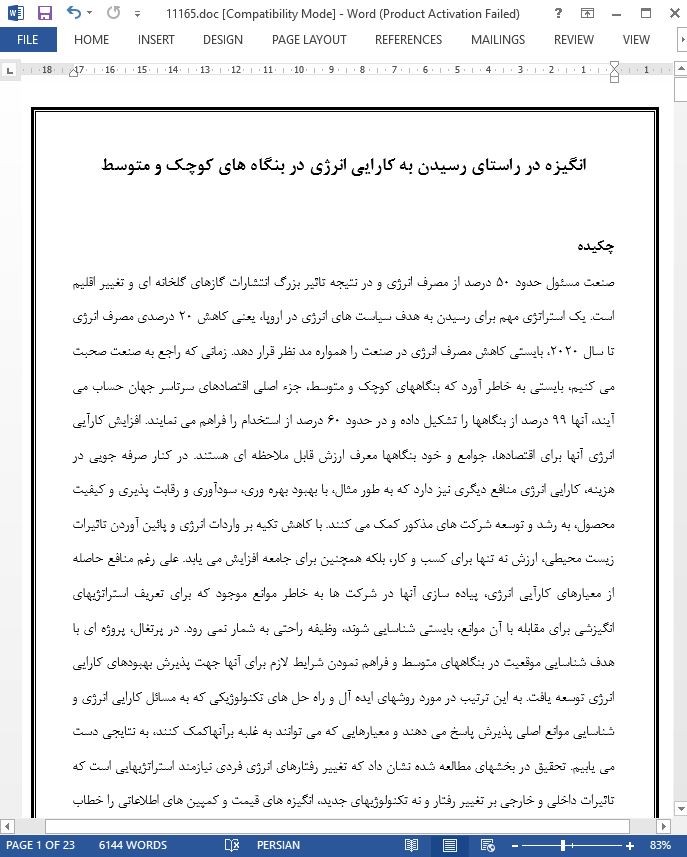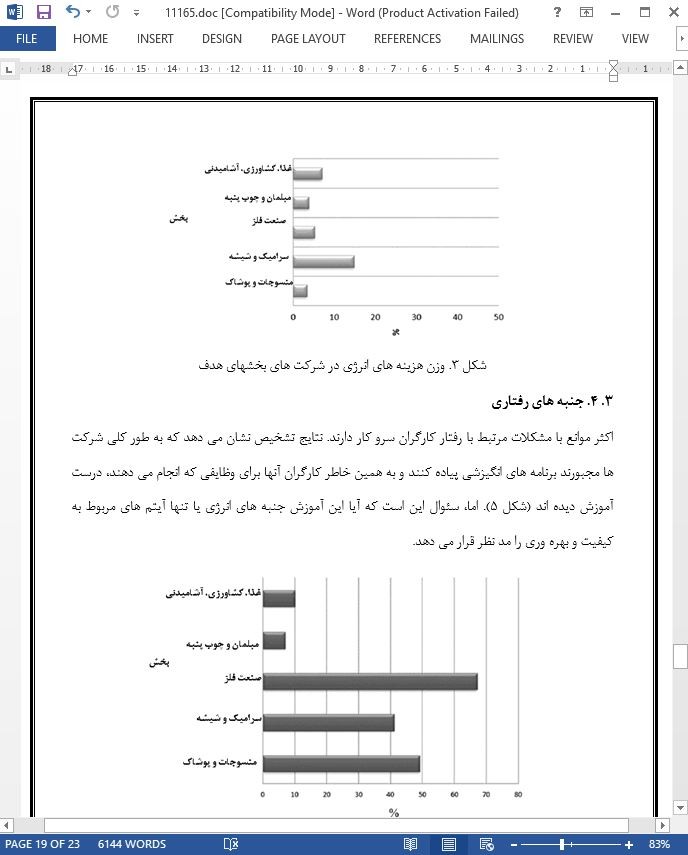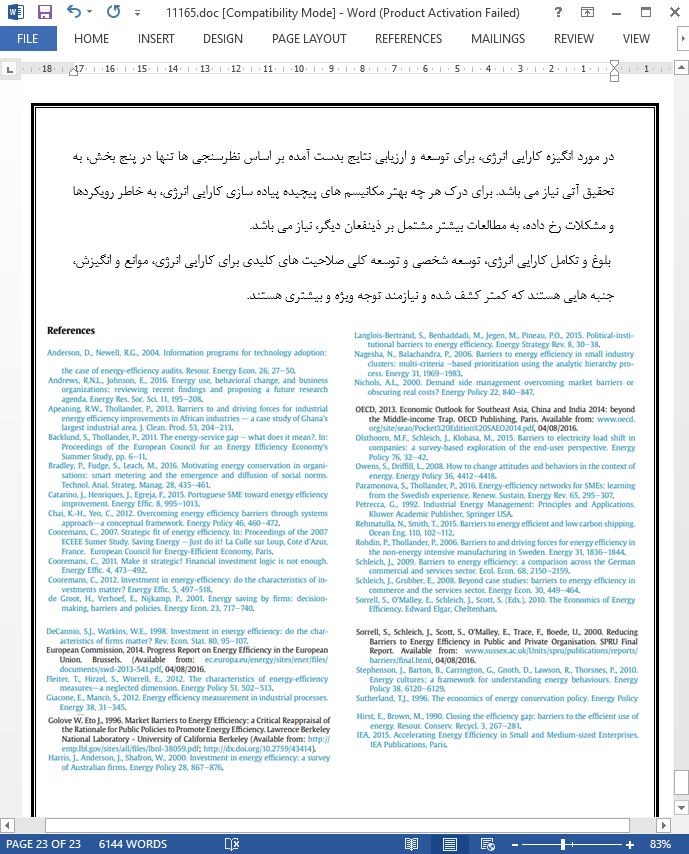
انگیزه در راستای رسیدن به کارایی انرژی در بنگاه های کوچک و متوسط
چکیده
صنعت مسئول حدود 50 درصد از مصرف انرژی و در نتیجه تاثیر بزرگ انتشارات گازهای گلخانه ای و تغییر اقلیم است. یک استراتژی مهم برای رسیدن به هدف سیاست های انرژی در اروپا، یعنی کاهش 20 درصدی مصرف انرژی تا سال 2020، بایستی کاهش مصرف انرژی در صنعت را همواره مد نظر قرار دهد. زمانی که راجع به صنعت صحبت می کنیم، بایستی به خاطر آورد که بنگاههای کوچک و متوسط، جزء اصلی اقتصادهای سرتاسر جهان حساب می آیند، آنها 99 درصد از بنگاهها را تشکیل داده و در حدود 60 درصد از استخدام را فراهم می نمایند. افزایش کارآیی انرژی آنها برای اقتصادها، جوامع و خود بنگاهها معرف ارزش قابل ملاحظه ای هستند. در کنار صرفه جویی در هزینه، کارایی انرژی منافع دیگری نیز دارد که به طور مثال، با بهبود بهره وری، سودآوری و رقابت پذیری و کیفیت محصول، به رشد و توسعه شرکت های مذکور کمک می کنند. با کاهش تکیه بر واردات انرژی و پائین آوردن تاثیرات زیست محیطی، ارزش نه تنها برای کسب و کار، بلکه همچنین برای جامعه افزایش می یابد. علی رغم منافع حاصله از معیارهای کارآیی انرژی، پیاده سازی آنها در شرکت ها به خاطر موانع موجود که برای تعریف استراتژیهای انگیزشی برای مقابله با آن موانع، بایستی شناسایی شوند، وظیفه راحتی به شمار نمی رود. در پرتغال، پروژه ای با هدف شناسایی موقعیت در بنگاههای متوسط و فراهم نمودن شرایط لازم برای آنها جهت پذیرش بهبودهای کارایی انرژی توسعه یافت. به این ترتیب در مورد روشهای ایده آل و راه حل های تکنولوژیکی که به مسائل کارایی انرژی و شناسایی موانع اصلی پذیرش پاسخ می دهند و معیارهایی که می توانند به غلبه برآنهاکمک کنند، به نتایجی دست می یابیم. تحقیق در بخشهای مطالعه شده نشان داد که تغییر رفتارهای انرژی فردی نیازمند استراتژیهایی است که تاثیرات داخلی و خارجی بر تغییر رفتار و نه تکنولوژیهای جدید، انگیزه های قیمت و کمپین های اطلاعاتی را خطاب قرار می دهند.
1. مقدمه
بنگاههای کوچک و متوسط که معرف 99 درصد از بنگاهها بوده و در حدود 60 درصد از استخدام را فراهم می کنند به عنوان جزء اصلی اقتصادهای سرتاسر جهان و همچنین پرتغال شناخته می شوند. آنها بسته به ساختار اقتصادی کشور، در حدود 50 درصد از ارزش افزوده ناخالص جهانی و 16 تا 80 درصد از تولید ناخالص داخلی (GDP) سهم دارند (IEA، 2015).
5. نتایج و آیتم هایی برای تحقیق و توسعه آتی
موانع کارایی انرژی، که اغلب در اکثر بنگاههای کوچک و متوسط گزارش شده اند، به منابع محدود آنها، انسانی یا مالی ربط داشته اند، یعنی، آنها بایستی بر روی مشکلات روزمره شان تاکید کنند. بنابراین، مشارکت آنها در جنبه های دیگر، همیشه یک وظیفه راحت نیست. مطالعات موردی Efinerg نشان دادند که رویکردهای عمومی برای مشکلات مواجه شده از سوی صنعت وجود ندارد، اما در نظر گرفتن خصوصیات متفاوت آنها لازم و ضروری است: اندازه شرکت، نوع فعالیت (تولیدی، خدمات یا کشاورزی)، بخش، شدت انرژی، موضوعات مربوط به تامین انرژی و ساختارهای مالکیت. به محض شناسایی چالش های خاص، تعریف و توسعه رویکردهای موثرتر، راحت تر خواهد شد.
Abstract
Industry is responsible for about 50% of world energy consumption and therefore for a big impact concerning greenhouse gas emissions and climate change. An important strategy to achieve the target of energy policies in Europe, of reducing the energy consumption by 20% by 2020, must consider reducing energy consumption in industry. When talking about industry, it must be remembered that small and medium-sized enterprises are a central part of economies worldwide, comprising 99% of enterprises and providing about 60% of employment. Increasing their energy efficiency represents considerable value for economies, societies and the enterprises themselves. Together with cost savings, energy efficiency can deliver other benefits that can help those companies grow and develop, for example by improving productivity, profitability and competitiveness and product quality. By reducing reliance on energy imports, and lowering environmental impacts, it increases value, not only to business, but also to society. Despite the benefits resulting from energy efficiency measures, their implementation in companies is not an easy task, due to existing barriers that must be identified in order to define motivation strategies that can fight those obstacles. A project, aiming to identify the situation in medium-sized enterprises and to provide them the necessary conditions to adopt energy efficiency improvements, was developed in Portugal. It enabled to conclude about best practices and technological solutions that answer the energy efficiency problems and to identify the main barriers that prevent that adoption, and measures that can contribute to overcome them. The research within the sectors studied showed that changing individual energy behaviors requires strategies that address both internal and external influences on behavior change and not simply new technologies, price incentives or information campaigns.
1. Introduction
Small and medium-sized enterprises representing 99% of enterprises and providing about 60% of employment are a central part of economies worldwide and therefore in Portugal too. They contribute around 50% of global gross value added and from 16% to around 80% of gross domestic product (GDP), depending on the country's economic structure (IEA, 2015).
5. Conclusions and items for future research and development
Barriers to energy efficiency, frequently reported in most of small and medium-sized enterprises, have been related to their limited resources, either human or financial ones, which imply that they must focus on their day-to-day problems. Therefore to get their involvement towards other aspects is not always an easy task. Efinerg case studies showed that there are no general approaches to the problems faced by industry but it is essential to take into consideration their different specificities: company size, type of activity (manufacturing, services or agriculture), sector, energy intensity, energy supply issues and ownership structures. Once specific challenges are identified it will be easier to define and develop more effective approaches.
چکیده
1. مقدمه
2. موانع در برابر انگیزه
1. 2 موانع
2. 2 انگیزه ها
3. 2. راههای غلبه بر موانع
3. تجربه پرتغالی
4. نتایج و بحث
1. 4 جنبه های سازمانی
2. 4 جنبه های اقتصادی
3. 4. جنبه های رفتاری
5. نتایج و آیتم هایی برای تحقیق و توسعه آتی
Abstract
1. Introduction
2. Barriers versus motivation
2.1. Barriers
2.2. Motivations
2.3. Ways to overcome barriers
3. The Portuguese experience
4. Results and discussion
4.1. Organizational aspects
4.2. Economic aspects
4.3. Behavioral aspects
5. Conclusions and items for future research and development
- اصل مقاله انگلیسی با فرمت ورد (word) با قابلیت ویرایش
- ترجمه فارسی مقاله با فرمت ورد (word) با قابلیت ویرایش، بدون آرم سایت ای ترجمه
- ترجمه فارسی مقاله با فرمت pdf، بدون آرم سایت ای ترجمه



